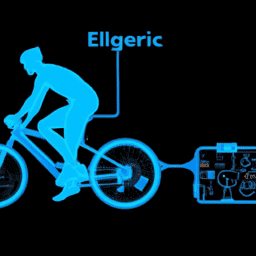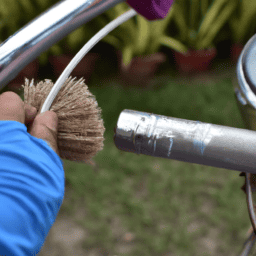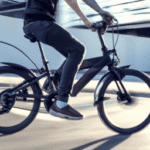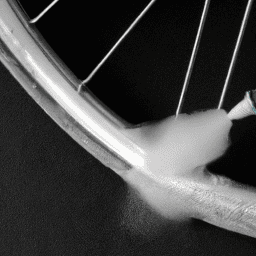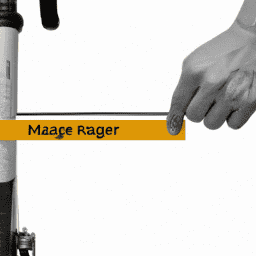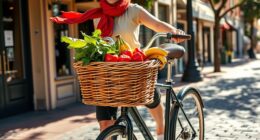If you’re interested in understanding electric bicycles and their operation, then you’ve found the perfect spot. Known as e-bikes, these electric bicycles are gaining popularity due to their capability to simplify and broaden the accessibility of cycling. They function similarly to traditional bicycles but include the additional advantage of an electric motor that offers help whenever required.
At the heart of an electric bicycle is the electric motor, which is powered by a battery. When you pedal, the motor kicks in to provide extra power, helping you to go faster and further with less effort. But how exactly does this all work?
In this article, we’ll break down the components of an electric bicycle, explain how the motor and battery work together, and explore the benefits of riding an e-bike. So buckle up (or rather, strap on your helmet) and let’s get started!
Key Takeaways
- E-bike components include an electric motor, motor controller, battery, frame, and suspension.
- The battery’s capacity determines energy storage and range, with lithium ion batteries having longer lifespan and higher energy density.
- Proper battery maintenance is important, including avoiding overcharging and deep discharging, storing in a cool dry place, and regularly cleaning terminals.
- E-bikes offer benefits such as reduced physical exertion and carbon emissions, and make cycling more accessible and efficient.
Components of an Electric Bicycle
You’re probably wondering what makes up an electric bicycle, so let’s take a look at its components.
The two most crucial components are the motor and controller. The motor is the device responsible for providing power to the bike while the controller is the one that manages the motor’s power. The motor can be located in different parts of the bike, such as the wheels, pedals, or bottom bracket. Meanwhile, the controller is typically placed near the battery. Both components work together to provide a smooth and efficient ride.
Aside from the motor and controller, the frame and suspension are also vital parts of an electric bicycle. The frame is responsible for supporting the weight of the rider and all the bike’s components, while the suspension helps absorb shock and impact from uneven terrain. A sturdy and durable frame is essential to ensure safety while riding, while the suspension guarantees a comfortable ride.
With these components working together, you’ll have a reliable and efficient electric bicycle that can take you on your adventures.
Now, let’s take a closer look at how the electric motor works.
How the Electric Motor Works
The key component powering an e-bike is the motor, which, with its intricate system of magnets and coils, generates the force needed to propel the rider forward. Here’s how the electric motor works:
-
Electric motor torque is produced when a magnetic field interacts with an electric current. In an e-bike, the motor’s permanent magnets create a magnetic field that interacts with the current in the motor’s coils to produce torque.
-
The motor controller function is to regulate the flow of electricity to the motor, controlling its speed and power output. It does this by monitoring the rider’s input, such as how hard they’re pedaling or twisting the throttle, and adjusting the amount of current flowing to the motor accordingly.
-
When the rider pedals or twists the throttle, the motor controller sends a signal to the motor, which receives the current and converts it into rotational motion.
-
As the motor spins, it turns the bike’s wheels, propelling the rider forward.
-
The amount of torque produced by the motor depends on several factors, including the strength of the magnetic field, the number of coils in the motor, and the amount of current flowing through it.
Now that you understand how the electric motor works, let’s move on to the next important component: the battery.
How the Battery Works
Now let’s dive into how the battery works in your electric bicycle.
There are different types of batteries available, each with their own advantages and disadvantages.
It’s important to consider the capacity and range of the battery, which will determine how far you can ride on a single charge.
Lastly, understanding the charging process is crucial to ensure your battery is always ready to go when you’re.
Types of Batteries
Get ready to power up your ride with a variety of battery options available for your electric bicycle!
When it comes to electric bike batteries, there are two main types: lithium ion and lead acid batteries. Lithium ion batteries are more expensive but offer a longer lifespan, higher energy density, and lighter weight. On the other hand, lead acid batteries are cheaper but heavier, have a shorter lifespan, and require more maintenance.
To maintain your battery’s lifespan, it’s important to properly care for it. Keep your battery charged between 20-80% to avoid overcharging and deep discharging, which can damage the battery. Store your battery in a cool, dry place and avoid exposing it to extreme temperatures. Finally, make sure to regularly clean the battery terminals and check for any signs of damage or wear and tear.
Now that you understand the different types of batteries and how to maintain them, let’s move on to the next topic: capacity and range.
Capacity and Range
You’re ready to hit the road with your electric bike and explore new places, but before you do, let’s talk about how much power you have at your fingertips and how far you can go with it.
The capacity of your battery refers to the amount of energy it can store, usually measured in watt-hours (Wh). Meanwhile, the range is the distance you can travel on a single charge, depending on various factors such as your weight, terrain, and speed.
To ensure that you have enough power to complete your ride, you need to know your battery’s capacity and range. Here are some things you should keep in mind:
- The higher the capacity, the more energy your battery can store, which means longer range.
- However, a higher capacity battery also means a longer charging time, so plan accordingly.
- Proper battery maintenance can extend its lifespan and optimize its performance, so make sure to follow the manufacturer’s recommendations.
Now that you know how to determine your electric bike’s capacity and range, let’s talk about how to recharge your battery and keep it in top condition for your next ride.
Charging
Charging your e-bike is essential to keep it running smoothly and efficiently for your next adventure. One way to charge your e-bike is through wireless charging. This method allows you to charge your e-bike without any wires or cables. All you need to do is place your e-bike on a wireless charging pad and it’ll start charging automatically.
Another way to charge your e-bike is through the use of solar panels. Solar panels can be attached to your e-bike or to a charging station. They convert sunlight into electricity, which is then stored in a battery. This method is environmentally friendly and can be used even when you’re in the middle of nowhere. Just make sure to position your e-bike or charging station in a sunny spot to maximize your charging time.
With your e-bike fully charged, you can now move on to the next section about pedaling and braking.
Pedaling and Braking
When you pedal an electric bicycle, you’re not just relying on the motor to do all the work. Instead, you can use a pedal assist system that helps you pedal more efficiently. This means that the motor will provide some extra power when you pedal, making it easier to climb hills or ride longer distances.
Additionally, electric bicycles often come equipped with regenerative braking systems, which can help recharge the battery when you brake. This means that you’re not only saving energy by using an electric bike, but you’re also able to recoup some of that energy when you slow down or stop.
Pedal Assist
Pedal assist is like having a trusty sidekick, giving you just the right amount of power to conquer any hill with ease. It’s an electric bike feature that provides a boost of power to the rider’s pedaling effort.
This feature is designed to make cycling more efficient by reducing the amount of energy needed to ride and improving the environmental impact of the bike. Using pedal assist has efficiency benefits that allow riders to travel farther and faster with less effort. The electric motor provides a boost that helps riders maintain a consistent speed, even on hills or in headwinds.
Additionally, pedal assist reduces the amount of physical exertion needed to ride, making cycling accessible to more people. This feature is also environmentally friendly because it reduces the amount of carbon emissions produced during transportation.
Overall, pedal assist is a valuable feature that enhances the cycling experience by providing a convenient and efficient means of transportation. As you continue to learn about electric bicycles, the next section will explore another important feature: regenerative braking.
Regenerative Braking
Get ready to experience a more sustainable ride with regenerative braking, an amazing feature that allows you to harness the power of braking to recharge your electric bike.
This technology works by converting the kinetic energy generated during braking into electrical energy, which is then stored in the battery for later use. This energy conversion not only optimizes the efficiency of your electric bike, but also reduces the wear and tear on your brakes, making them last longer.
Regenerative braking is an important feature of electric bicycles because it helps to extend your riding range and reduce the need to charge your battery as often. Moreover, this technology also contributes to a more eco-friendly and sustainable mode of transportation, as it allows you to reduce your carbon footprint while still enjoying the convenience and comfort of an electric bike.
With regenerative braking, you can take advantage of the power of your bike to optimize your energy usage and get the most out of your ride.
Moving on to the benefits of electric bicycles, you’ll be amazed at how much they can transform your daily commute and leisure activities.
Benefits of Electric Bicycles
You’ll love the leisurely, low-impact ride an electric bicycle provides, boosting your health and happiness. But did you know that riding an electric bicycle can also benefit the environment and save you money in the long run?
Electric bicycles have a lower environmental impact than traditional gas-powered vehicles. They produce zero emissions and use less energy to operate. This means that not only are you reducing your carbon footprint, but you’re also helping to improve air quality in your community. Additionally, electric bicycles are cost-effective in the long run. While the initial purchase price may be higher than a traditional bicycle, the cost savings from not having to buy gas or pay for maintenance on a gas-powered vehicle can add up over time. Plus, with electric bicycles becoming more popular, the price is decreasing, making them more accessible to a wider range of individuals.
| Benefit | Explanation |
|---|---|
| Health | Boosts health and fitness through low-impact exercise |
| Environment | Zero emissions, improves air quality |
| Cost-Effective | Saves money in the long run, no need for gas or expensive maintenance |
So not only will an electric bicycle provide you with a fun and easy mode of transportation, but it can also have a positive impact on both your wallet and the environment. With benefits like these, it’s easy to see why electric bicycles are becoming a more popular choice for commuters and recreational riders alike.
Frequently Asked Questions
What is the average lifespan of an electric bicycle battery?
The average lifespan of an electric bicycle battery is influenced by various factors such as usage, charging habits, and environmental conditions. Expect to pay for battery replacement cost after around 2-4 years of use.
Can I ride an electric bicycle in the rain?
Yes, you can ride an electric bicycle in the rain, but you must adjust your riding technique accordingly. Use a lower power setting, maintain a steady speed to prevent skidding, and dry the bike after use. Regular maintenance tips include keeping the battery and connections dry.
How much does an electric bicycle weigh compared to a traditional bicycle?
Did you know that electric bicycles typically weigh 20-30 pounds more than traditional bicycles? Electric bicycle weight distribution is also different, with the motor and battery adding weight to the frame.
Do I need a special license to ride an electric bicycle?
To ride an electric bicycle, you don’t need a special license. However, you must follow safety regulations, such as wearing a helmet, using lights at night, and staying within speed limits.
How long does it take to fully charge an electric bicycle battery?
You might be wondering how long it takes to fully charge your electric bicycle battery. The charging time depends on its capacity, usually taking between 2-6 hours. Check the manufacturer’s guidelines for specific charging instructions.
Conclusion
Congratulations! You now have a deeper understanding of how electric bicycles work.
You know that an electric bicycle is made up of several components, including the electric motor and battery. The electric motor works by converting electrical energy from the battery into mechanical energy that propels the bicycle forward. The battery, on the other hand, stores the electrical energy that powers the motor.
When riding an electric bicycle, you can choose to pedal or not. Pedaling can help conserve battery power, while not pedaling relies entirely on the electric motor.
You’ve also learned about the benefits of riding an electric bicycle, including reduced carbon emissions and improved cardiovascular health.
Think of your electric bicycle as a symbol of your commitment to a sustainable future. You’re not just riding a bike, but you’re actively reducing your carbon footprint and promoting a healthier lifestyle.
With your electric bicycle, you’re making a positive impact on the environment and your own well-being. So, keep pedaling and enjoy the ride!
